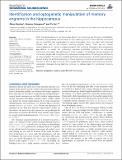Identification and optogenetic manipulation of memory engrams in the hippocampus
Author(s)
Ramirez Moreno, Steve; Tonegawa, Susumu; Liu, Xu
DownloadTonegawa_Identification and.pdf (565.7Kb)
PUBLISHER_POLICY
Publisher Policy
Article is made available in accordance with the publisher's policy and may be subject to US copyright law. Please refer to the publisher's site for terms of use.
Terms of use
Metadata
Show full item recordAbstract
With the accumulation of our knowledge about how memories are formed, consolidated, retrieved, and updated, neuroscience is now reaching a point where discrete memories can be identified and manipulated at rapid timescales. Here, we start with historical studies that lead to the modern memory engram theory. Then, we will review recent advances in memory engram research that combine transgenic and optogenetic approaches to reveal the underlying neuronal substrates sufficient for activating mnemonic processes. We will focus on three concepts: (1) isolating memory engrams at the level of single cells to tag them for subsequent manipulation; (2) testing the sufficiency of these engrams for memory recall by artificially activating them; and (3) presenting new stimuli during the artificial activation of these engrams to induce an association between the two to form a false memory. We propose that hippocampal cells that show activity-dependent changes during learning construct a cellular basis for contextual memory engrams. - See more at: http://journal.frontiersin.org/Journal/10.3389/fnbeh.2013.00226/full#sthash.BuOvbac0.dpuf
Date issued
2014Department
Massachusetts Institute of Technology. Department of Biology; Massachusetts Institute of Technology. Department of Brain and Cognitive Sciences; Picower Institute for Learning and MemoryJournal
Frontiers in Behavioral Neuroscience
Publisher
Frontiers Media S.A.
Citation
Ramirez, Steve, Susumu Tonegawa, and Xu Liu. "Identification and optogenetic manipulation of memory engrams in the hippocampus". Frontiers in Behavioral Neuroscience 7.226 (2013): 1-9.
Version: Final published version
ISSN
1662-5153